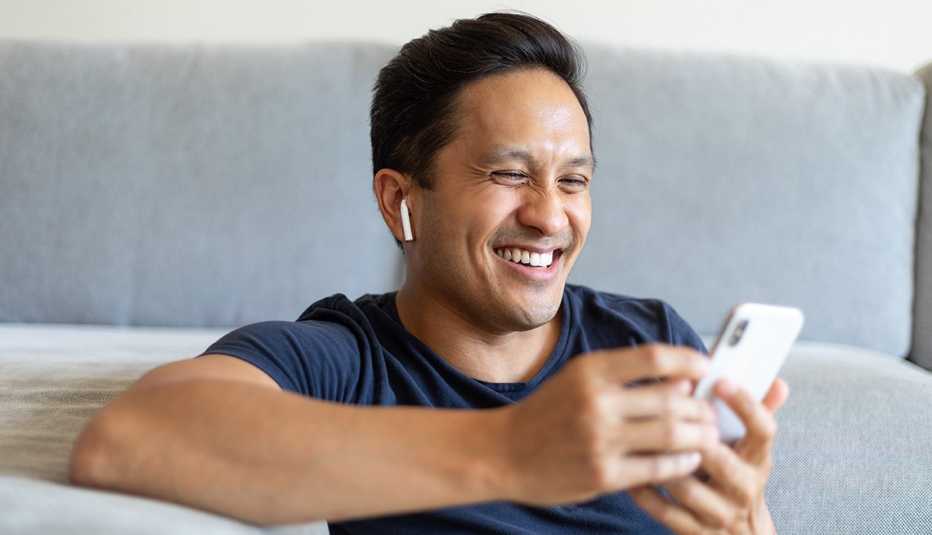Staying Fit


In this story
Headphone jacks rare • Many Bluetooth devices • Decoding wireless terminology • Bluetooth and sound • How to connect
These days, you really have to hunt for a smartphone with a headphone jack.
Apple removed the standard 3.5-millimeter jack for earbuds or headphones starting with the iPhone 7, released in 2016. One Android brand left them off starting in 2012, but major player Samsung waited until 2019 to make the leap with its Galaxy Note 10 and a set of wireless Galaxy Buds.


AARP Membership— $12 for your first year when you sign up for Automatic Renewal
Get instant access to members-only products and hundreds of discounts, a free second membership, and a subscription to AARP the Magazine.
Now you can almost count the number of new phones with these jacks on one hand. So if you’ve been using your phone to listen to music or carry on a conversation without wireless earbuds or headphones, it’s time to embrace Bluetooth.
Bluetooth is a short-range wireless communication technology, named after 10th century Viking king Harald “Bluetooth [Blåtand]” Gormsson, who had a blue-gray dead tooth. You may be using this tech already if you have a wireless mouse without the separate thumbnail-size receiver that you must plug into a USB port.
Many devices use Bluetooth technology
Decoding wireless lingo
Bluetooth. This short-range wireless technology standard allows two nearby devices to connect directly to each other without cables.
NFC. Near-field communication is a short-range wireless technology that transmits data via electromagnetic induction, which creates a small, invisible burst of electricity when a magnet is moved near a metal wire, but no battery or other electricity is involved. A special reader tracks metal tags using this technology. Generally, both the reader and the tag need to be within about an inch and a half of one another. NFC technology is found on contactless credit cards in your wallet.
RFID. Radio-frequency identification also uses electromagnetic induction to track tags, but distances can be greater, valuable for inventory tags in retail stores and toll transponders such as E-ZPass and TxTag. RFID uses numerous radio frequencies and is the overall technology; NFC is a subset at a specific radio frequency.
Wi-Fi. This radio signal sent from a wireless router provides high-speed internet access simultaneously to multiple devices nearby. Its range is wider than Bluetooth and can handle more devices. The name is not a shortened form of wireless fidelity.
Most fitness trackers and smartwatches connect to your smartphone using Bluetooth. Wireless keyboards often connect to laptops and tablets via Bluetooth.
Your iPhone’s AirDrop feature and Android phones’ Nearby Share use both Bluetooth and Wi-Fi to share photos and files from smartphones with friends who have similar phones. Video game pads and controllers communicate with their consoles through Bluetooth.
Some soundbars link with newer smart TVs via Bluetooth. The newest hearing aids connect with smartphones and smart TVs via Bluetooth.
Keyless door locks can use Bluetooth to allow your phone to open them. Travel padlocks ditch the tiny wheels of a combination lock to allow you to open them from an app on your phone. Even smart toothbrushes that can monitor and track your brushing habits sync with your smartphone via Bluetooth.
If you’re not plugging your smartphone into your vehicle’s USB port to use a map app for navigation or listen to a playlist via Spotify or another music and podcast streaming service, a Bluetooth connection can accomplish the task.
Bluetooth is best known for sound
But when people think of Bluetooth, they think of wireless speakers, which can broadcast your phone’s or stereo’s music at a party, or wireless headsets, which can be as small as earbuds or as big as over-the-ear headphones. If you don’t already have a set that was included with your smartphone, you’ll need to buy it.
Be aware that sound quality can vary among the various brands of earbuds, headphones and speakers. If the devices use Bluetooth, they can be connected to any stereo receiver or smartphone with Bluetooth.
Wireless earbuds and headphones marketed for Android smartphones range from about $10 to nearly $450. Headphones are $20 to nearly $700. Earbuds and headphones that are the same brand as your smartphone are likely to have additional features, such as Find My Device when you’ve misplaced them.



































































More From AARP
Why You Should Connect Your Mobile Phone to Your Home's Wi-Fi
Cure problems with poor signal strength, weak audio, data overages
Use Your Smartphone’s Hot Spot to Connect to Wi-Fi
Many mobile phone and plans now allow this optionHow Fast Does Your Internet Need To Be to Stream Video?
Number of devices, their uses are part of the equation